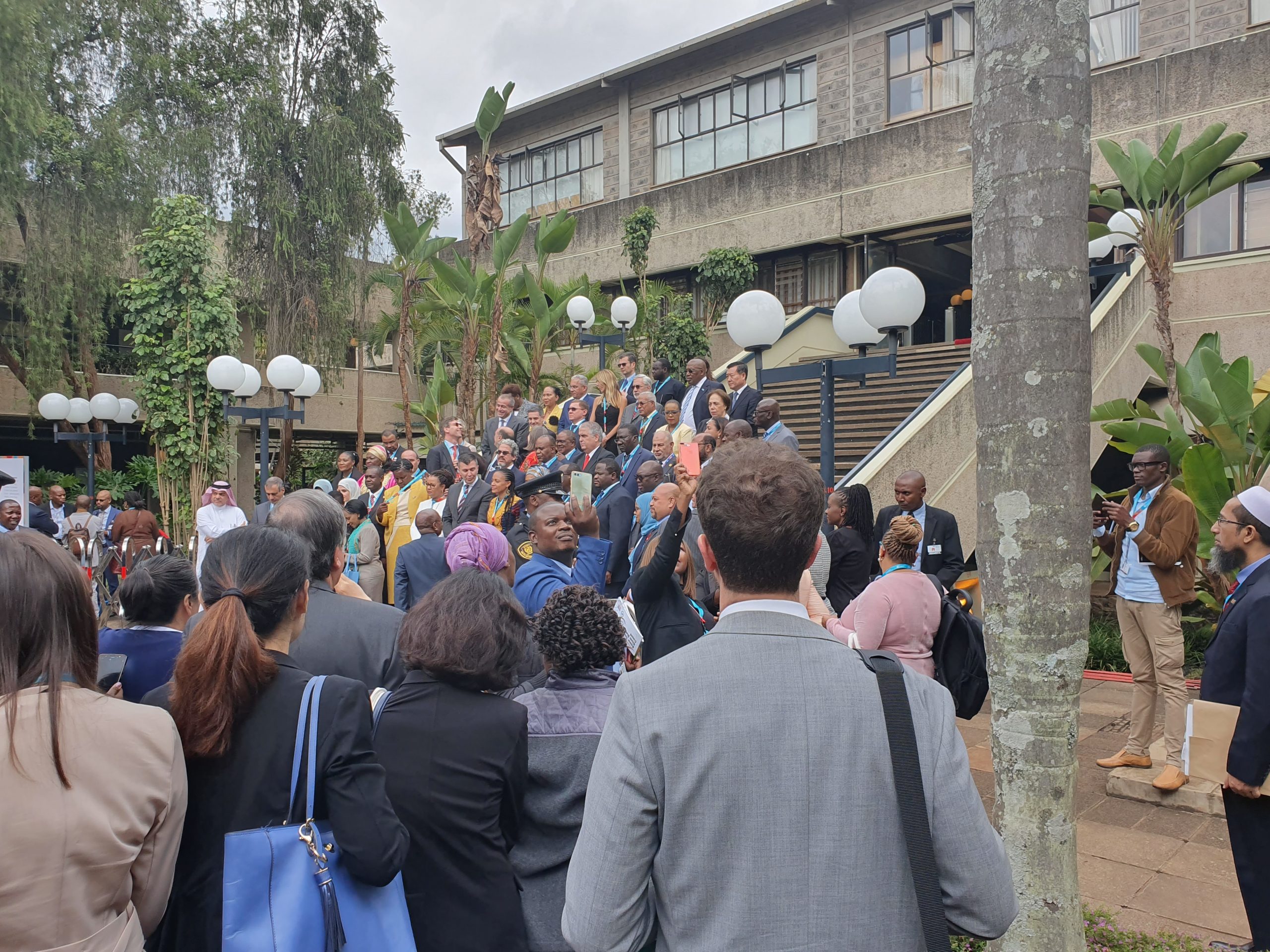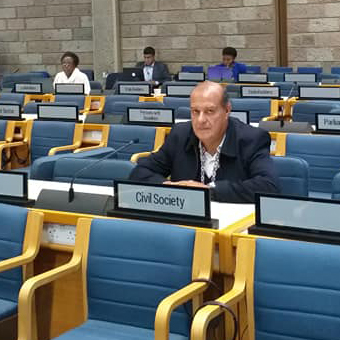25th– 31stMay 2019
The Global Platform for the Right to the City (GPR2C) participated in the 1st UN-Habitat Assembly to bring the voice of its members expressed in the collective declaration on the UN-Habitat 2020-2025 strategic plan.

Note by Frederick Kusambiza, Planact Executive Director
The GPR2C was represented by five delegates at the United Nations Habitat Assembly (UNH-A) meeting: Ana Falú, Red Mujer y Hábitat and GPR2C women and gender working group coordinator, Frederick Kusambiza from Planact, Jane Katz from Habitat for Humanity, Joseph Schechla from HIC Housing and Land Rigths Network, Malick Gaye de ENDA RUP and Nelson Saule from Polis Institute and GPR2C coordinator. The UNH-A happened under the theme – “Innovation for a Better Quality of Life in Cities and Communities” and was conducted in two sessions.
The first session, which was referred to as the pre-session, was called the ‘Global Stakeholders Forum (GSF) – Caucusing’, which was held from 25th May 2019 to 26th May 2019. This session dealt with reviewing how Stakeholders would engage with the UNH-A.
During the two day session, delegates of the GSF deliberated on how to address their role in fostering innovation for sustainable, inclusive and liveable cities and communities in line with the Sustainable Development Goals (SDGs) and the New Urban Agenda (NUA). One of the afternoon the GSF delegates had an opportunity to engage in a ‘question and answer’ discussion with the Executive Director of the UN-Habitat, Maimunah Mohd Sharif. In this discussion Ms. Sharif stated that the bureau was setting up or organising its operational mechanism to meet what it has (UNH) set out to do in the Stakeholder Policy.
Ms. Sharif also announced that there will be an inauguration of the Advisory Panel on the Stakeholder Policy, specifically on how to engage Stakeholders. However, our observation was that the panel selected to represent Stakeholders was chosen without consultation or input from Stakeholders and the selected people, did not seem fitting to take on this role.
This again illustrated how UN-Habitat has a less committed relationship with the Stakeholders. Our understanding is that UN-Habitat needs to strongly understand that all the other sectors it priorities like the various government and government institutions, and the private institutions are in existence because of their respective citizens in each country. Citizens form up the Stakeholder sector (within the UNH language) therefore Stakeholders should have a greater priority!
The second session, which run from 27th May to 31st May 2019 had plenary presentations, side events, city stage events, special and regional events. GPR2C delegates attended, the opening plenary, a number of side events.
[i]The President of Kenya, Uhuru Kenyatta, formally opened the first UN-Habitat Assembly at the UNH Office at Nairobi. Guests included ministers and high-level Member States representatives, governors, mayors, representatives of civil society and non-governmental organizations, academics and business leaders.
Welcoming the international guests to Kenya, President Kenyatta emphasized the need for collective international action to address the challenges of rapid urbanization saying many societies were ill prepared to plan properly. He said that given the challenges, the overall theme of the Assembly namely ‘Innovation for a Better Quality of Life in Cities and Communities’ was fitting and timely.”
The director executive’s remarks made at the opening of the UNH-A pointed out that the United Nations Assembly accepted that the governing structure of the UNH, which was the Governing Council, should be changed to become the United Nations Habitat Assembly (UNH-A). It was for this reason the UNH-A was created. Ms. Martha Delgado ,who comes from Mexico in Latin America, was elected as the president of the UNH-A.
Another high level event was where four heads of states from Kenya, South Sudan, Fiji and Yemen were in an interactive dialogue discussing Policy Segment on creating an enabling environment on innovation. The discussion touched on resilience and preparedness of cities regarding urbanization, urban planning and housing, and the involvement of private sector.

On 31 May, Nelson Saule presented the GPR2C statement on UN-Habitat’s Strategic Plan[ii]. The GPR2C believes that the focus of the Assembly, the Strategic Plan 2020-2025, makes steps in the right direction, it falls short in the key areas central to our mission. We advocated at the UNH-A that:
- The ‘Right to the City’, which is fundamental to achieving the SDGs and NUA and which was explicitly enshrined in the latter, must be included in the SP2020-25; without this, it fails to pursue the paradigm shift needed to achieve these goals of fundamental importance.
- Women must be involved in urban planning, local governance and decision-making processes related to their urban environments.
- That Sustainable Development, mentioned throughout but not defined in the SP2020-25, must not be pursued at the expense of local democracy and metropolitan governance; both are mentioned only once throughout the entire document.
- The social function of land must be recognised, that the informal economy must be given greater attention, and that Housing and Land Property Rights should be seen within the context of the Housing Rights approach, including specific mention to individual and collective, traditional and state-based forms of tenure other than private property.
- Regarding UN-Habitat’s new organizational scheme, we do not see a clear model for engaging civil society groups.
Ana Falú, GPR2C women and gender working group coordinator, also presented the Women’s Right to the City Manifesto[iii]. This document collects the 11 central points to make Women’s Right to the City a reality. To this end, cities must be free from discrimination and violence against women and must guarantee their political participation, gender balance and the realization of Human Rights in all human settlements.
Throughout the five days session,GPR2C delegates participated in various side events. A summary of four out of eight side events, are given below:
- Community-driven Data to create resilient Cities – Improving the Lives of Slum Dwellers and delivering on Sustainable Development Goals (SDGs) and NUA through Tenure Security, where it was highlighted that local governments, needed to have accurate data to be able to contend with urbanisation, while communities needed to get information on land tenure;
- Not Just a Roof: Promoting spatial equality and justice through the right to adequate housing, where the importance of promoting the right to adequate housing and its implementation, particularly in the context of the NUA and the SDGs was reinforced. Further to this issues there was a discussion on housing rights solutions that enable to avoid spatial fragmentation;
- Sustainable Human Settlement as Catalysts of SDG11, where stock was taken on measuring the initiatives of creating safer cities through the Global UN Habitat Safer Cities Programme.It was evident from the discussion that evidence-based approach was crucial in creating and promoting safe and sustainable settlements;
- New Urban Agenda Platform: Fostering Innovation to accelerate Implementation of the NUA towards achieving the SDGs. This event discussed the progress on developing the New Urban Agenda (NUA) Platform and the Member State Reporting Guidelines on the implementation of the NUA. It was reported that the platform would be launched at the World Urban Forum 10 (WUF) in February 2020. The NUA Platform will respond to the need to enhance the visibility on progress being made on the implementation of the NUA.
The UNH-A and the NUA can be successful if there is genuine and transparent cooperation amongst the different categories in society, professionals, social movements, government institutions, business or private sector and public sector. Information to enhance knowledge should be freely given and shared. Appreciating the widening gap between haves and have nots will allow a feeling of solidarity to those citizens that suffer the most in society.
————————————————————
[i]Quoted from the UN-Habitat Bulletin.
[ii] GPR2C Statement on UN-Habitat’s Strategic Plan: https://www.right2city.org/wp-content/uploads/2019/06/UN-Habitat-2019-Assembly-Statement.pdf
[iii] Women’s Right to the City Manifesto: http://www.righttothecityplatform.org.br/wp-content/uploads/Womens-Right-to-the-City-Manifesto_EN.pdf




